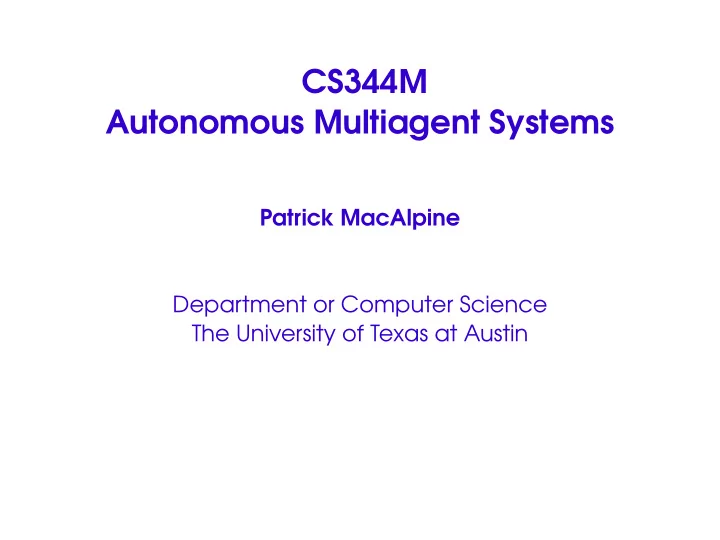

CS344M Autonomous Multiagent Systems Patrick MacAlpine Department or Computer Science The University of Texas at Austin
Good Afternoon, Colleagues Are there any questions? Patrick MacAlpine
Good Afternoon, Colleagues Are there any questions? − Is there a deceit paradigm? − Marketing oriented approaches? − Are basis behaviors relevant? − Why does CMUnited kick ball to corners? − How does self interest benefit system as a whole? Patrick MacAlpine
Logistics • Programming assignment 3 — how was it? Patrick MacAlpine
Logistics • Programming assignment 3 — how was it? • Programming assignment 4 Patrick MacAlpine
Logistics • Programming assignment 3 — how was it? • Programming assignment 4 • Final “Exam”: Wednesday, December 9, 7:00-10:00 pm Patrick MacAlpine
Individual Agents What did Sycara say about reactive vs. deliberative agents? Patrick MacAlpine
Individual Agents What did Sycara say about reactive vs. deliberative agents? “Sophisticated individual agent reasoning can increase MAS coherence because each individual agent can reason about nonlocal effects of local actions, form expectations of the behavior of others, or explain and possibly repair conflicts and harmful interactions.” “Reactive agents do not have representations of their environment and act using a stimulus-response type of behavior; they respond to the present state of the environment in which they are situated.” Patrick MacAlpine
Individual Agents • Purely reactive agents have disadvantages – Can’t react to nonlocal info or predict effects on global behavior – hard to engineer • Purely reactive agents have advantages – no need to revise world model – robustness and fault tolerance if one agent fails • Hybrid approach better • Hard to evaluate agent architecture against one another Patrick MacAlpine
Conflicts, Resources • Omniscience for one agent creates bottleneck Patrick MacAlpine
Conflicts, Resources • Omniscience for one agent creates bottleneck • Self-interested agents: each agent maximizes own local utility – Will that be good for global performance? Patrick MacAlpine
Conflicts, Resources • Omniscience for one agent creates bottleneck • Self-interested agents: each agent maximizes own local utility – Will that be good for global performance?(invisible hand) Patrick MacAlpine
Conflicts, Resources • Omniscience for one agent creates bottleneck • Self-interested agents: each agent maximizes own local utility – Will that be good for global performance?(invisible hand) – Pitfall: Patrick MacAlpine
Conflicts, Resources • Omniscience for one agent creates bottleneck • Self-interested agents: each agent maximizes own local utility – Will that be good for global performance?(invisible hand) – Pitfall:tragedy of the commons – Pitfall: no stability – Pitfall: lying Patrick MacAlpine
Conflicts, Resources • Omniscience for one agent creates bottleneck • Self-interested agents: each agent maximizes own local utility – Will that be good for global performance?(invisible hand) – Pitfall:tragedy of the commons – Pitfall: no stability – Pitfall: lying • Market-based methods/auctions Patrick MacAlpine
Conflicts, Resources • Omniscience for one agent creates bottleneck • Self-interested agents: each agent maximizes own local utility – Will that be good for global performance?(invisible hand) – Pitfall:tragedy of the commons – Pitfall: no stability – Pitfall: lying • Market-based methods/auctions • Negotiation, game theory Patrick MacAlpine
Multiagent Planning • Complex individual agents • Teamwork modeling – Modeling of teammates and opponents – Ad-hoc teamwork • Recent: emphasis on flexibility in dynamic environments Patrick MacAlpine
Multiagent Planning • Complex individual agents • Teamwork modeling – Modeling of teammates and opponents – Ad-hoc teamwork • Recent: emphasis on flexibility in dynamic environments • (pursuit slides) Patrick MacAlpine
Pursuit Activity Group 1: homogeneous, non-communicating Group 2: homogeneous, communicating Group 3: heterogeneous, non-communicating Group 4: heterogeneous, communicating Patrick MacAlpine
Communication • Middle agents (brokers) • Standard languages • Ontologies More next week Patrick MacAlpine
Mataric: Adaptive Group Behavior • Built using subsumption architecture Patrick MacAlpine
Mataric: Adaptive Group Behavior • Built using subsumption architecture • More complex behaviors than in Brooks’ article – Multiagent Patrick MacAlpine
Mataric: Adaptive Group Behavior • Built using subsumption architecture • More complex behaviors than in Brooks’ article – Multiagent • Hit a complexity limit? − (Subsumption or 3T more prevalent?) Patrick MacAlpine
Basis Behaviors • Necessary and sufficient, not “optimal” Patrick MacAlpine
Basis Behaviors • Necessary and sufficient, not “optimal” – Task dependent – Combinations: complementary, contradictory Patrick MacAlpine
Basis Behaviors • Necessary and sufficient, not “optimal” – Task dependent – Combinations: complementary, contradictory • Example: locomotion Patrick MacAlpine
Basis Behaviors • Necessary and sufficient, not “optimal” – Task dependent – Combinations: complementary, contradictory • Example: locomotion – Safe-wandering, following, dispersion, aggregation, homing Patrick MacAlpine
Basis Behaviors • Necessary and sufficient, not “optimal” – Task dependent – Combinations: complementary, contradictory • Example: locomotion – Safe-wandering, following, dispersion, aggregation, homing – What 2 compound multiagent behaviors does she describe? Patrick MacAlpine
Basis Behaviors • Necessary and sufficient, not “optimal” – Task dependent – Combinations: complementary, contradictory • Example: locomotion – Safe-wandering, following, dispersion, aggregation, homing – What 2 compound multiagent behaviors does she describe? ∗ flocking ∗ foraging Patrick MacAlpine
Basis Behaviors • Necessary and sufficient, not “optimal” – Task dependent – Combinations: complementary, contradictory • Example: locomotion – Safe-wandering, following, dispersion, aggregation, homing – What 2 compound multiagent behaviors does she describe? ∗ flocking ∗ foraging – Anything special about this domain? Or could it apply just as well to others? Patrick MacAlpine
Discussion Basis behaviors for other tasks Patrick MacAlpine
Discussion Basis behaviors for other tasks • Can human behavior be thought of as arising from a set of basis behaviors? • What kinds of basis behaviors would they be? Patrick MacAlpine
Discussion Basis behaviors for other tasks • Can human behavior be thought of as arising from a set of basis behaviors? • What kinds of basis behaviors would they be? • Would they be the same as the ones Mataric listed? • Are there others? Patrick MacAlpine
CMUnited-98 • The details of a complete agent • Details of complete UT Austin Villa 3D agent optional reading • Any comments? Patrick MacAlpine
Recommend
More recommend